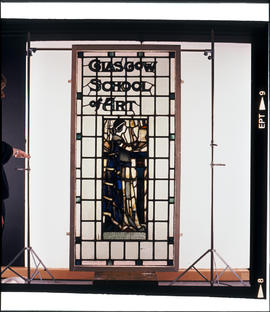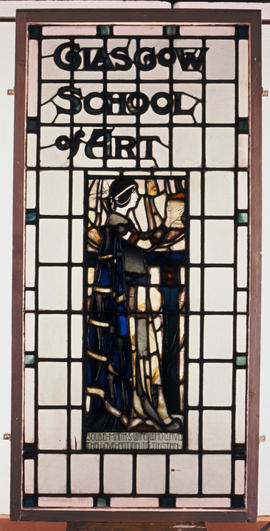Key Information
Reference code
Title
Date(s)
- 1901 (Creation)
Level of description
Item
Extent
1
Content and Structure
Scope and content
Stained glass panel. Inscribed above: "Glasgow School of Art"; below: "Isolde Mark's wife who gave the love potion to Tristan". It was one of Fra Newbery's considerable achievements to see the need for training students in industrial art and design and persuade the governors to establish a decorative arts department. His annual report of 1893 announces 'This room has been specially fitted up and artist craftsmen have been engaged to give instruction in such subjects as glass staining, pottery, repousse and metalwork, wood carving and book binding, beside Artistic Needlecraft taught by a Lady.' Early teachers of stained glass at the GSA included Norman Macdougall, Harry Roe and William Stewart. Among the students were Jessie Rowat, Emily Hutcheson, Herbert MacNair, Stephen Adam Jr, W.G Morton and Dorothy Carleton Smyth.
Appraisal, destruction and scheduling
Accruals
System of arrangement
General Information
Name of creator
Biographical history
Born in Glasgow of Irish and French parentage. From 1885-1893 she attended Colonel Clark’s School, Manchester & The Manchester High School for Girls. From 1893-1897 she studied at The Manchester School of Art, under Walter Crane. From 1898-1904 she was at GSA as a student and also teaching ( from 1898-1903). She was awarded the Diploma in 1902. Classes included Stained Glass, Enamels, Illustration, Sgraffito, Gesso and metal work. From Mar-July 1903 she travelled in Paris, Italy and Switzerland visiting Studios, etc. Between 1904-1914 she worked as a theatre and costume designer in Glasgow, London and Europe. Companies included Louis Verande, Paris Opera, Granville Barker and the Quinlan Opera Company.
Between 1915-1933 she returned to teach full-time at GSA concentrating on Costume, Lithography and Book Illustration. In 1927 became Head of the Pictorial Section of the School of Design and specialised in teaching Illustration. In 1933 was offered and accepted the post of Director of the Glasgow School of Art, but died (16 Feb 1933), aged 52, of a brain haemorrhage before the appointment was made public and W.O. Hutchison took up the position. Dorothy had a sister, Olive Carleton Smyth, who was also a successful professional artist and a fellow teacher at the School. She took over as Head of Design when Dorothy died.
Dorothy worked as a professional artist while teaching. Her early work included the production of local plays in Glasgow, sometimes working with Charles Rennie Mackintosh and others of the Glasgow School on decoration. From the 1920s she undertook book illustrations for Chiver’s, Blackie and Collins. She worked in silverwork, sculpture (including modelling friezes and panels for the Allan Liners “Victoria” and “Virginia”). She was known as a successful portrait painter and broadcast extensively on art subjects, including art lessons for children on the BBC (as Paint Pot Pixie). Smyth also ran the Drama Club at the School between 1924 and 1933.
Archival history
Exhibited: Glasgow, International Exhibition;1901. Glasgow. The People's Palace; 1981. Glasgow, Glasgow School of Art; 1988. Glasgow, Glasgow Museum and Art Gallery; 1990. Edinburgh (City Art Centre), Sheffield (Millennium Galleries) and Aberdeen (Art Gallery); 2007-2008.
Custodial history
Probably gift of Rose Carleton Smyth, who presented works by her sisters Dorothy and Olive Carleton Smyth, 1949.
Physical Description and Conditions of Use
Conditions governing access
Conditions governing reproduction
Language of material
Script of material
Language and script notes
Physical Description
Stained glass panel
Dimensions: 1910 x 870 mm



